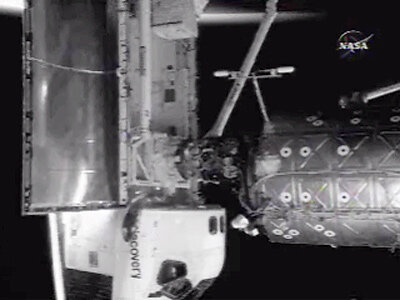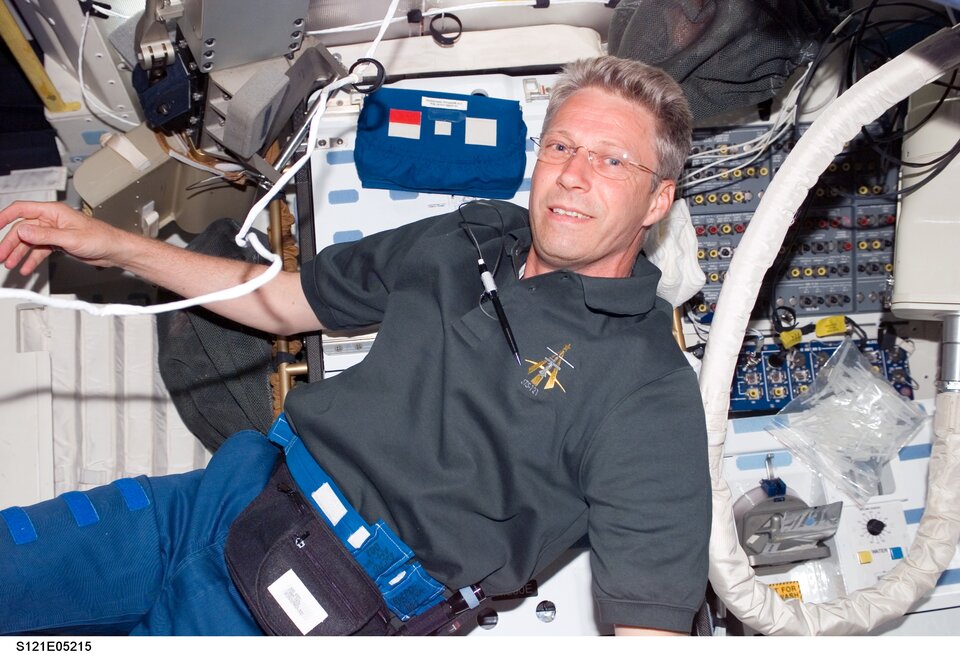Flight day 2
Inspection
After eight hours sleep we are awakened by music transmitted from Ground Control. It is traditional to play special music in the morning for the crew, often music that the relatives of the crew have chosen.
During flight day 2 we test the Space Shuttle’s robotic arm and the spacewalk suits and prepare for docking with the Space Station the next day. A large part of the day is also spent checking the Space Shuttle’s heat shields; to make sure that nothing has damaged them during the launch, which is what happened with Columbia and sealed her fate three years ago.
Along the outside of the port side of the cargo bay lies the 15 m long robotic arm, which is controlled from the flight deck. Along the outside of the starboard side we have an equally long boom. Nick grips one end of the boom with the robotic arm and then slowly sweeps the other end, with the camera, along the wings and the nose and around and under the Space Shuttle and in this way scans the heat shields.
Flight day 3

Rendezvous
On the third day we dock with the International Space Station. The complete operation is called rendezvous and takes half of the day and a number of rocket-thrusts. The last kilometre is flown manually by the Commander.
Around 200 m from the ISS we come to a stop and do a back-flip. This is so that the Space Station crew can photograph the underside of Discovery to further ensure that we don’t have any damage to the heat shields. In the final stages the whole crew is involved in the approach and docking. The duties consist of everything from taking photographs to carrying out independent distance and speed measurements with a laser. My major responsibility is the docking system itself: starting it up and making sure it does what it should, which in practice means pressing a number of buttons at the right time.
When we have docked and checked that the connections are air-tight, we then open the hatches and there are happy greetings and warm hugs exchanged with all the crew members. On board the ISS there is an American (Michael Lopez-Alegria), a Russian (Mikhail Tyurin) and a German. The German is ESA-astronaut Thomas Reiter, a good friend of mine, since we trained together in Russia 1993–1995.
Thomas has been on the ISS for almost half a year, since the Space Shuttle Discovery’s previous mission STS-121 docked here at the beginning of July. He will soon be returning to Earth and Sunni will take his place on the ISS. The two others came up with a Soyuz capsule in September and still have several months ahead of them up here.
On the ISS

The greetings and welcoming ceremony, which will also be transmitted live on TV, are not drawn out for long and instead we quickly go over to work. Firstly, we newcomers have a briefing about the Space Station, especially about safety and the procedures to be carried out in an emergency situation. Then, using the Space Shuttle's robotic arm, P5 is taken out of the Space Shuttle's cargo bay and transferred to the Space Station’s robotic arm, Canadarm2.
Our suits for the spacewalk are installed in the Space Station’s airlock, Quest, as well as tools and other things that we need for the next day’s spacewalk, or EVA (Extra Vehicular Activity) in NASA-jargon. After a briefing about the upcoming spacewalk, which everyone participates in, Beamer and I are then sealed into the airlock. We spend the night there, where the pressure is lower and the partial oxygen pressure is slightly higher, in order to minimise the risk of 'the bends' in connection with the spacewalk.
Normal air conditions exist on the ISS, that is an atmospheric pressure (as at sea level) and 20 percent oxygen. To make the spacesuits less clumsy you have pure oxygen in them and the pressure is kept at only 0.3 atmospheres. When the body is subjected to pressure reductions, bubbles of nitrogen gas can form, which in the worst cases can be directly life threatening. The same problem is encountered by divers who rise to the surface too quickly.
In the context of the spacewalk several procedures have been developed in order to deal with this risk, by 'flushing out' nitrogen from the body before the pressure is reduced. In our case, Beamer and I sleep in 0.7 atmospheres with little over 25 percent oxygen and before the pressure in the air-lock is restored in the morning we don oxygen masks (100 percent oxygen); the inconvenience of which we have to put up with for a while during the morning toilet visit etc.




